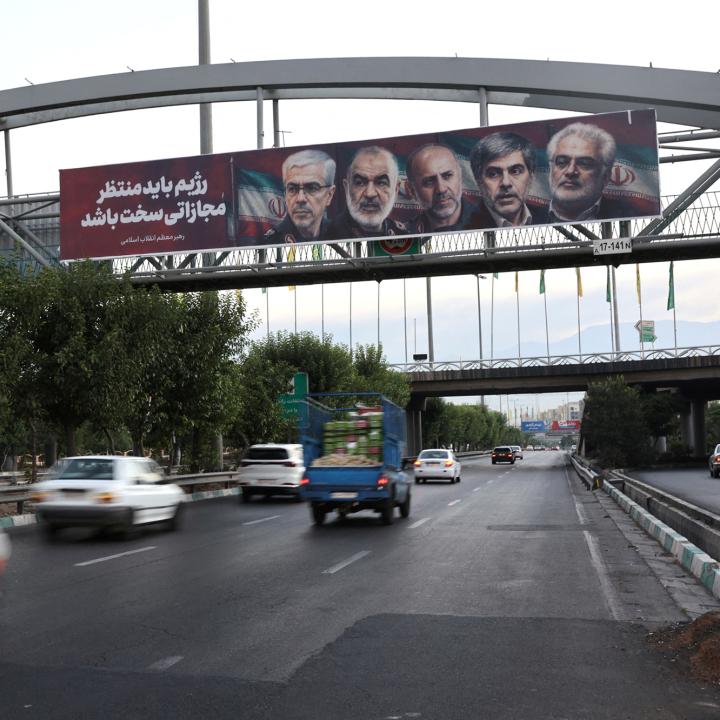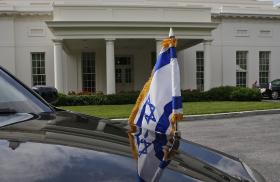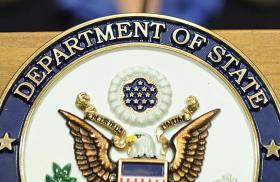
- Policy Analysis
- PolicyWatch 4057
The Bigger Picture in the Iran-Israel Conflict: Russia, Missiles, Militias, and More

Four experts assess how outside players might respond to the showdown, and whether Tehran will switch up its calculus on procurement, attack tactics, and other military matters as the fight goes on.
On June 20, The Washington Institute held a virtual Policy Forum with Anna Borshchevskaya, Michael Knights, Farzin Nadimi, and Assaf Orion. Borshchevskaya is the Institute’s Grinspoon Senior Fellow, focusing on Russian policy toward the Middle East. Knights is the Institute’s Bernstein Senior Fellow and co-creator of its Militia Spotlight platform. Nadimi is a senior fellow at the Institute, specializing in the security and defense affairs of Iran and the Persian Gulf region. Orion is the Institute’s Rueven International Fellow, a senior research fellow at INSS, and former head of the Israel Defense Forces Strategic Planning Division. The following is a rapporteur’s summary of their remarks.
Note: This forum took place the day before the United States launched direct strikes on Iran’s nuclear facilities, so the analysis reflects this development as a possible scenario rather than a fait accompli.
Anna Borshchevskaya
Russian President Vladimir Putin sees the current Iran-Israel conflict as fluid and prefers to maintain good relations with all sides for the time being. In his view, the ideal situation would be some kind of ceasefire with Moscow serving as the mediator, since that could help bring Russia out of international isolation, divert attention from its war in Ukraine, and reassert its status as a great power rather than a pariah. Importantly, Russia’s strategic partnership with Iran does not require it to come to the regime’s aid in times of war.
Putin also believes that the positives and negatives of the United States joining the conflict would cancel each other out. On one hand, direct U.S. involvement would distract the West from the war in Ukraine, where Putin has staked his reputation and believes he can win. The Iran conflict might also cause a meaningful rise in oil prices, which would embolden him to expend more resources in Ukraine. On the other hand, few if any countries would seriously consider Russia as a potential mediator between Israel and Iran. Putin has also suffered serious reputational damage for failing to come to Tehran’s rescue.
As for the bilateral defense relationship, Moscow resented its dependence on Iran for drones in the early stages of the Ukraine war and took steps to eliminate that dependence. Although Tehran is still helping Russia in certain respects, drones are no longer the primary avenue of their defense relations, and the Kremlin does not depend on receiving replacements from Iran anymore.
As always, Moscow’s primary focus is global confrontation with the West, so its priorities in the Iran-Israel crisis will necessarily diverge from Washington and Jerusalem’s. Whereas they are most concerned about Tehran’s nuclear program, Russia is more concerned about the prospect of Tehran turning pro-Western or undergoing regime collapse. This turn of events would further damage Putin’s position in the region and his overall geopolitical calculus.
For now, Putin remains fairly confident about his country’s position, though he is watching the conflict with caution. Although Russia is not actively supporting Iran at the moment, it could decide to do more if further involvement suits Moscow’s broader anti-Western interests.
Michael Knights
For the most part, the regional militias that make up Iran’s “axis of resistance” have been keen to sit out the latest fight with Israel, and this posture of deliberate inaction is more focused, purposeful, and cohesive than their response to the outbreak of the Gaza war in 2023. Yet their restraint is conditioned on whether or not the United States enters the conflict. Indeed, the two main triggers for dramatic militia escalation would be direct U.S. strikes on Iran or the targeted killing of Supreme Leader Ali Khamenei.
Iran’s proxies show their utility when they pursue escalation options that Tehran might not take itself. The Yemeni Houthis in particular have demonstrated the ability and willingness to fire increasingly advanced medium-range ballistic missiles at Israel for the foreseeable future. They are also Tehran’s primary proxy for using large-scale conventional military capabilities to threaten regional shipping lanes, the Gulf states, and U.S. military bases. The perception that the Houthis exercise some degree of independence and are “un-deterrable” makes them especially useful for hitting such locations. They have maintained a line of supply for dual-use machinery to make missiles and drones as well, while their remaining arsenal is deeper than what officials had hoped following repeated military strikes in Yemen. Similarly, Iraqi militias may prove their utility to Tehran by launching drones from the south toward the Gulf states.
More broadly, authorities should keep in mind that regimes like the Islamic Republic are quite durable. Although it is easy to damage them, it is very difficult to decisively topple them, especially without a viable replacement. If Khamenei leaves the scene in the near term, the ensuing instability and escalation might hasten the regime’s fracturing and create rival camps. A valuable model to identify early indications of regime frailty is Saddam Hussein’s Iraq in the late 1990s.
Farzin Nadimi
In general, Iran’s military strategy depends on its missile force and ability to defend its airspace. In the current conflict, its barrages against Israel have subsided significantly, suggesting that Tehran is not acting as recklessly as it could. This might also indicate that Israel’s preemptive strikes and missile defenses are largely working, and that Tehran is conserving its resources and recalibrating its escalation options in case of direct U.S. involvement.
Going forward, Iran could change the nature of the fight by employing more advanced weaponry or using cyberattacks, sabotage, terrorism, and proxy actions to pressure Israel without triggering direct U.S. military intervention. The regime is unlikely to order the mining of sea lanes unless Israel severely disrupts Iranian oil installations. And if Washington launches airstrikes on the Fordow nuclear installation, Iran would likely constrain its retaliation to a limited number of precise missile attacks against already emptied parts of U.S. bases in the region so as not to cause significant damage or inflict casualties.
Meanwhile, Iran may seek modern air defense systems like the S-400 from Russia or even China. Yet it would probably not be able to receive them anytime soon, in part because Russia is still trying to restock its own supplies. Notably, Moscow is now more or less self-sufficient in drone production, so it may not need further shipments of them from Tehran—though the Iranians may still be providing piston engines.
To stem the loss of top commanders from the Islamic Revolutionary Guard Corps, Iran has rushed regular army officers from the Artesh into positions previously held by IRGC officers only. Yet these replacements have not led to any significant differences in daily operations or top-level dynamics, where IRGC elements still hold sway. Although the crisis has literally pushed the IRGC and Artesh closer together for now, the friction between these national military pillars will likely grow in the future.
Among its other targeting priorities, Israel has attacked the headquarters of Iranian units tasked with suppressing popular uprisings—a clear attempt to encourage the Iranian people to take matters into their own hands. If Israeli operations expand to include the political leadership, such dynamics in Iran could accelerate. At the beginning of the campaign, the chances of regime collapse seemed quite high, but the leadership might still be able to hold on absent significant cascading developments.
If the regime does collapse, some friction between ethnic minority groups can be expected, since their views of the regime vary. Yet Iran’s national cohesion and civil society would hopefully rise to the challenge.
Assaf Orion
A major shift has occurred at the strategic level now that Iran is directly at war with Israel after historically preferring to fight by proxy. The regime’s three pillars of offensive power—nuclear, missile, and proxy capabilities—are all being challenged, while the country’s defenses and deterrence are being heavily undermined. At the operational level, Israel enjoys almost total freedom of action in Iranian airspace.
Given the White House’s two-week ultimatum to Iran, the Israel Defense Forces will need to maintain their attacks until Washington’s chosen course of action regarding Fordow is clear. This means continuing offensive efforts to degrade the nuclear program throughout the entire supply chain, from the early stages of uranium conversion and enrichment to weaponization. Israel’s aims have also expanded to include targets that undermine regime stability, including economic targets (as evidenced by recent cyberattacks on the banking sector). In addition, the contest between Israel’s air defenses and Iran’s launching capabilities will shape the remainder of the conflict.
Ultimately, the crisis will continue until Israel achieves its war goals—degrading the regime’s ballistic missile and nuclear capabilities—and Iran stops its strikes, or until the United States intervenes to further those goals. The challenge will be translating these military achievements into something more substantive with regard to Iran’s nuclear program, Gaza, or the Abraham Accords. Accurately gauging Tehran’s capabilities, capacity, and calculus after the fighting concludes will also be important.
Outside the region, China is taking a cautious line on the conflict, urging both sides toward restraint and diplomacy (though Beijing has been more vocal in condemning Israel). Chinese leaders are unlikely to make any military commitments, consistent with how they usually deal with such crises. They are also concerned about Iranian oil supplies and regime collapse, since the latter outcome could inspire instability elsewhere, including in Beijing. Moreover, they do not want the United States to be seen as victorious in this crisis or as the sole trusted security guarantor in the region, in part because they fear this would free Washington up to focus on the Indo-Pacific.
This summary was prepared by Michelle Fan. The Policy Forum series is made possible through the generosity of the Florence and Robert Kaufman Family.






